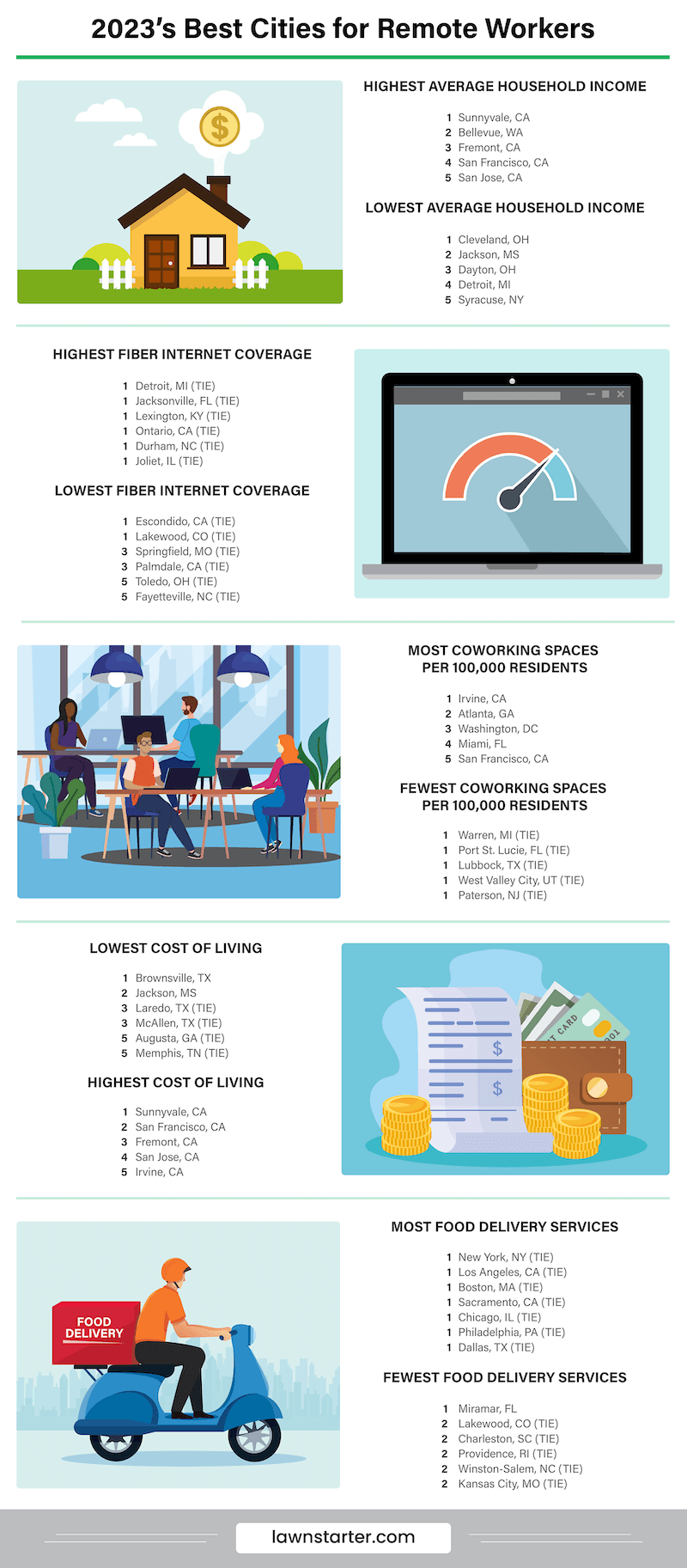
Freedom of location is one of the biggest perks of remote work. With a strong Wi-Fi connection, you could take Zoom calls from a beachside villa, a mountaintop chalet, or a lawn chair in your backyard.
To help you find the optimal spot for your telecommuter lifestyle, LawnStarter ranked 2023’s Best Cities for Remote Workers.
We compared the 200 biggest U.S. cities based on 20 remote worker-friendliness factors, such as internet quality, cost of living, and access to coworking spaces. We even considered financial bonuses that local and state governments offer prospective telecommuting incomers.
Check out our ranking below, followed by some highlights, lowlights, and expert insights on adapting to an “untethered” professional life.
Contents
City Rankings
See how each city fared in our ranking:
| Overall Rank (1=Best) | City | Overall Score | Financial Incentive Rank | Earning Potential Rank | Workspace Rank | Connectivity Rank | Affordability Rank | Safety Rank | Amenities Rank |
|---|---|---|---|---|---|---|---|---|---|
| 1 | Plano, TX | 67.11 | 7 | 19 | 6 | 41 | 6 | 27 | 94 |
| 2 | Frisco, TX | 67.02 | 7 | 6 | 3 | 108 | 2 | 5 | 146 |
| 3 | Tampa, FL | 65.69 | 7 | 55 | 11 | 12 | 32 | 41 | 51 |
| 4 | Atlanta, GA | 63.99 | 7 | 31 | 10 | 21 | 77 | 149 | 17 |
| 5 | Seattle, WA | 63.48 | 7 | 8 | 29 | 10 | 113 | 180 | 78 |
| 6 | Durham, NC | 63.26 | 7 | 68 | 42 | 4 | 61 | 163 | 69 |
| 7 | Austin, TX | 63.06 | 7 | 32 | 113 | 13 | 36 | 135 | 9 |
| 8 | Kansas City, MO | 62.55 | 7 | 121 | 62 | 3 | 29 | 180 | 182 |
| 9 | Jacksonville, FL | 62.23 | 7 | 135 | 114 | 5 | 60 | 104 | 4 |
| 10 | Charlotte, NC | 62.08 | 7 | 47 | 52 | 22 | 45 | 128 | 48 |
| 11 | Raleigh, NC | 61.96 | 7 | 51 | 61 | 23 | 41 | 61 | 87 |
| 12 | Houston, TX | 61.42 | 7 | 104 | 83 | 27 | 19 | 174 | 38 |
| 13 | Nashville, TN | 61.39 | 7 | 82 | 66 | 15 | 65 | 174 | 25 |
| 14 | Naperville, IL | 61.32 | 7 | 7 | 4 | 146 | 7 | 1 | 52 |
| 15 | Dallas, TX | 61.30 | 7 | 93 | 153 | 7 | 51 | 149 | 10 |
| 16 | San Antonio, TX | 61.30 | 7 | 156 | 97 | 8 | 48 | 163 | 27 |
| 17 | El Paso, TX | 61.03 | 7 | 168 | 111 | 9 | 22 | 14 | 98 |
| 18 | Fort Wayne, IN | 60.79 | 7 | 169 | 63 | 25 | 21 | 75 | 100 |
| 19 | Carrollton, TX | 60.42 | 7 | 50 | 67 | 33 | 17 | 23 | 145 |
| 20 | Portland, OR | 59.99 | 7 | 42 | 9 | 11 | 140 | 174 | 160 |
| 21 | McKinney, TX | 59.82 | 7 | 22 | 22 | 156 | 3 | 5 | 20 |
| 22 | Cincinnati, OH | 59.79 | 7 | 162 | 81 | 17 | 52 | 149 | 117 |
| 23 | Joliet, IL | 59.74 | 7 | 67 | 137 | 39 | 8 | 23 | 43 |
| 24 | Bellevue, WA | 59.19 | 7 | 2 | 2 | 133 | 124 | 92 | 13 |
| 25 | Denver, CO | 59.12 | 7 | 33 | 57 | 26 | 116 | 180 | 81 |
| 26 | Olathe, KS | 58.80 | 7 | 29 | 12 | 93 | 11 | 17 | 157 |
| 27 | Irving, TX | 58.44 | 7 | 76 | 143 | 47 | 12 | 85 | 137 |
| 28 | Indianapolis, IN | 58.29 | 7 | 136 | 79 | 48 | 24 | 149 | 83 |
| 29 | Philadelphia, PA | 58.19 | 7 | 144 | 139 | 6 | 119 | 123 | 87 |
| 30 | Salt Lake City, UT | 58.12 | 7 | 74 | 48 | 29 | 107 | 198 | 91 |
| 31 | Knoxville, TN | 58.05 | 7 | 170 | 38 | 34 | 93 | 163 | 5 |
| 32 | Arlington, TX | 58.00 | 7 | 125 | 163 | 18 | 42 | 97 | 115 |
| 33 | Grand Rapids, MI | 57.84 | 7 | 159 | 37 | 42 | 83 | 75 | 47 |
| 34 | St. Louis, MO | 57.82 | 7 | 174 | 28 | 35 | 70 | 192 | 174 |
| 35 | Overland Park, KS | 57.66 | 7 | 28 | 32 | 111 | 13 | 41 | 138 |
| 36 | Louisville, KY | 57.19 | 7 | 131 | 80 | 44 | 59 | 149 | 133 |
| 37 | Pittsburgh, PA | 57.14 | 7 | 117 | 26 | 81 | 35 | 128 | 82 |
| 38 | Oklahoma City, OK | 57.11 | 7 | 142 | 93 | 37 | 63 | 149 | 103 |
| 39 | Murfreesboro, TN | 57.02 | 2 | 77 | 30 | 113 | 43 | 88 | 21 |
| 40 | Birmingham, AL | 56.95 | 7 | 192 | 1 | 63 | 130 | 192 | 28 |
| 41 | Spokane, WA | 56.67 | 7 | 145 | 8 | 84 | 64 | 174 | 24 |
| 42 | Minneapolis, MN | 56.61 | 7 | 63 | 94 | 38 | 99 | 180 | 109 |
| 43 | Providence, RI | 56.52 | 7 | 107 | 160 | 14 | 100 | 75 | 199 |
| 44 | Greensboro, NC | 56.52 | 7 | 154 | 103 | 40 | 74 | 149 | 65 |
| 45 | Clarksville, TN | 56.38 | 7 | 167 | 70 | 61 | 56 | 75 | 29 |
| 46 | Denton, TX | 56.35 | 7 | 120 | 44 | 73 | 54 | 37 | 154 |
| 47 | Omaha, NE | 56.31 | 7 | 95 | 105 | 67 | 34 | 113 | 172 |
| 48 | Lincoln, NE | 56.18 | 7 | 128 | 7 | 101 | 49 | 92 | 93 |
| 49 | Tacoma, WA | 56.06 | 7 | 83 | 89 | 58 | 81 | 192 | 56 |
| 50 | Boise, ID | 55.90 | 7 | 61 | 45 | 70 | 102 | 30 | 122 |
| 51 | Huntsville, AL | 55.80 | 7 | 80 | 43 | 112 | 20 | 135 | 33 |
| 52 | Lexington, KY | 55.78 | 7 | 114 | 13 | 105 | 40 | 104 | 72 |
| 53 | Orlando, FL | 55.70 | 7 | 122 | 36 | 71 | 101 | 149 | 15 |
| 54 | Chicago, IL | 55.55 | 7 | 59 | 131 | 57 | 86 | 107 | 60 |
| 55 | Little Rock, AR | 55.24 | 7 | 105 | 120 | 86 | 16 | 192 | 50 |
| 56 | Rochester, NY | 55.22 | 1 | 191 | 95 | 19 | 151 | 128 | 55 |
| 57 | New York, NY | 55.20 | 7 | 43 | 181 | 1 | 200 | 65 | 85 |
| 58 | Lubbock, TX | 54.92 | 7 | 153 | 35 | 127 | 14 | 174 | 34 |
| 59 | Scottsdale, AZ | 54.91 | 7 | 9 | 5 | 159 | 78 | 49 | 22 |
| 60 | Akron, OH | 54.87 | 7 | 195 | 107 | 32 | 79 | 149 | 105 |
| 61 | Garland, TX | 54.21 | 7 | 147 | 158 | 59 | 57 | 75 | 106 |
| 62 | Chesapeake, VA | 54.02 | 7 | 44 | 17 | 122 | 91 | 41 | 76 |
| 63 | Chattanooga, TN | 53.87 | 7 | 137 | 19 | 95 | 33 | 192 | 97 |
| 64 | Midland, TX | 53.86 | 7 | 69 | 85 | 162 | 9 | 75 | 14 |
| 65 | Fort Lauderdale, FL | 53.78 | 7 | 40 | 138 | 60 | 123 | 163 | 153 |
| 66 | Columbus, OH | 53.72 | 7 | 155 | 41 | 87 | 72 | 113 | 108 |
| 67 | Colorado Springs, CO | 53.70 | 7 | 73 | 33 | 80 | 104 | 128 | 89 |
| 68 | Macon, GA | 53.64 | 7 | 165 | 24 | 144 | 37 | 135 | 1 |
| 69 | Tulsa, OK | 53.58 | 2 | 146 | 16 | 135 | 38 | 180 | 62 |
| 70 | Pembroke Pines, FL | 53.45 | 7 | 79 | 71 | 77 | 121 | 14 | 190 |
| 71 | Cape Coral, FL | 53.37 | 7 | 111 | 58 | 94 | 122 | 7 | 31 |
| 72 | Fort Worth, TX | 53.23 | 7 | 86 | 106 | 123 | 23 | 99 | 46 |
| 73 | Milwaukee, WI | 53.23 | 7 | 182 | 151 | 45 | 98 | 149 | 170 |
| 74 | Detroit, MI | 53.19 | 7 | 197 | 154 | 16 | 133 | 174 | 194 |
| 75 | Winston-Salem, NC | 53.14 | 7 | 126 | 88 | 134 | 25 | 2 | 64 |
| 76 | Las Vegas, NV | 53.10 | 7 | 118 | 92 | 68 | 118 | 85 | 188 |
| 77 | Grand Prairie, TX | 52.90 | 7 | 110 | 109 | 118 | 18 | 41 | 110 |
| 78 | Virginia Beach, VA | 52.86 | 7 | 49 | 74 | 132 | 73 | 14 | 6 |
| 79 | Phoenix, AZ | 52.80 | 7 | 85 | 150 | 74 | 115 | 128 | 32 |
| 80 | St. Paul, MN | 52.73 | 7 | 97 | 155 | 66 | 114 | 163 | 84 |
| 81 | Corpus Christi, TX | 52.67 | 7 | 143 | 86 | 88 | 27 | 135 | 101 |
| 82 | Newport News, VA | 52.63 | 7 | 158 | 99 | 65 | 128 | 65 | 61 |
| 83 | Des Moines, IA | 52.46 | 7 | 152 | 148 | 78 | 82 | 149 | 90 |
| 84 | Kansas City, KS | 52.34 | 7 | 171 | 171 | 72 | 69 | 163 | 111 |
| 85 | Waco, TX | 52.32 | 7 | 164 | 121 | 124 | 31 | 135 | 16 |
| 86 | Hampton, VA | 52.30 | 7 | 129 | 76 | 96 | 97 | 69 | 74 |
| 87 | Henderson, NV | 52.21 | 7 | 46 | 23 | 143 | 46 | 20 | 189 |
| 88 | Mesquite, TX | 52.16 | 7 | 133 | 152 | 82 | 26 | 113 | 169 |
| 89 | Aurora, IL | 52.06 | 7 | 64 | 164 | 121 | 39 | 7 | 163 |
| 90 | Roseville, CA | 52.04 | 7 | 20 | 14 | 117 | 145 | 37 | 66 |
| 91 | Fort Collins, CO | 51.82 | 7 | 65 | 20 | 136 | 84 | 75 | 58 |
| 92 | West Valley City, UT | 51.82 | 7 | 113 | 135 | 64 | 94 | 113 | 195 |
| 93 | Pasadena, TX | 51.77 | 7 | 141 | 177 | 109 | 4 | 88 | 184 |
| 94 | Norfolk, VA | 51.70 | 7 | 148 | 49 | 91 | 106 | 107 | 128 |
| 95 | Oakland, CA | 51.61 | 7 | 25 | 167 | 2 | 185 | 192 | 141 |
| 96 | Memphis, TN | 51.59 | 7 | 173 | 142 | 103 | 28 | 198 | 131 |
| 97 | Alexandria, VA | 51.45 | 7 | 11 | 126 | 115 | 131 | 33 | 124 |
| 98 | Jersey City, NJ | 51.43 | 7 | 24 | 179 | 20 | 166 | 21 | 186 |
| 99 | Wichita, KS | 51.41 | 7 | 151 | 39 | 147 | 15 | 180 | 54 |
| 100 | Dayton, OH | 51.22 | 7 | 198 | 46 | 90 | 96 | 163 | 126 |
| 101 | Chandler, AZ | 51.04 | 7 | 26 | 101 | 165 | 58 | 33 | 129 |
| 102 | Tallahassee, FL | 50.53 | 7 | 160 | 128 | 150 | 44 | 123 | 2 |
| 103 | San Francisco, CA | 50.41 | 7 | 4 | 104 | 24 | 197 | 163 | 180 |
| 104 | Sioux Falls, SD | 50.29 | 7 | 62 | 69 | 194 | 1 | 107 | 144 |
| 105 | Mobile, AL | 50.24 | 7 | 178 | 21 | 152 | 47 | 88 | 112 |
| 106 | Sacramento, CA | 50.21 | 7 | 72 | 144 | 56 | 155 | 107 | 8 |
| 107 | Richmond, VA | 50.17 | 7 | 130 | 84 | 120 | 108 | 107 | 40 |
| 108 | Rockford, IL | 50.06 | 7 | 186 | 47 | 141 | 66 | 128 | 37 |
| 109 | New Orleans, LA | 49.94 | 7 | 134 | 60 | 85 | 132 | 180 | 192 |
| 110 | Fremont, CA | 49.92 | 7 | 3 | 185 | 30 | 174 | 75 | 155 |
| 111 | Port St. Lucie, FL | 49.82 | 7 | 108 | 68 | 177 | 76 | 3 | 39 |
| 112 | Baltimore, MD | 49.82 | 4 | 140 | 90 | 104 | 129 | 163 | 164 |
| 113 | Cleveland, OH | 49.59 | 7 | 200 | 54 | 79 | 137 | 180 | 185 |
| 114 | McAllen, TX | 49.56 | 7 | 150 | 159 | 176 | 10 | 36 | 63 |
| 115 | Peoria, AZ | 49.56 | 7 | 34 | 118 | 173 | 67 | 18 | 99 |
| 116 | Washington, DC | 49.44 | 7 | 12 | 51 | 97 | 153 | 149 | 134 |
| 117 | Miami, FL | 49.42 | 7 | 123 | 91 | 51 | 159 | 107 | 59 |
| 118 | Elk Grove, CA | 49.37 | 7 | 21 | 50 | 100 | 152 | 23 | 149 |
| 119 | Warren, MI | 49.11 | 7 | 157 | 165 | 130 | 50 | 30 | 191 |
| 120 | Thornton, CO | 49.07 | 7 | 45 | 65 | 167 | 75 | 104 | 181 |
| 121 | San Jose, CA | 48.80 | 7 | 5 | 169 | 55 | 175 | 135 | 120 |
| 122 | Vancouver, WA | 48.76 | 7 | 92 | 53 | 142 | 92 | 128 | 132 |
| 123 | Tucson, AZ | 48.74 | 7 | 175 | 141 | 89 | 138 | 135 | 18 |
| 124 | Bakersfield, CA | 48.64 | 7 | 96 | 180 | 46 | 149 | 135 | 80 |
| 125 | Killeen, TX | 48.42 | 7 | 185 | 122 | 151 | 55 | 69 | 70 |
| 126 | Fresno, CA | 48.26 | 7 | 124 | 168 | 43 | 154 | 113 | 41 |
| 127 | Madison, WI | 48.04 | 7 | 94 | 55 | 155 | 90 | 92 | 175 |
| 128 | Amarillo, TX | 48.00 | 7 | 139 | 64 | 200 | 5 | 149 | 11 |
| 129 | Shreveport, LA | 47.98 | 7 | 176 | 31 | 178 | 53 | 180 | 7 |
| 130 | Riverside, CA | 47.74 | 7 | 81 | 156 | 28 | 171 | 113 | 42 |
| 131 | Albuquerque, NM | 47.67 | 7 | 127 | 82 | 119 | 111 | 180 | 178 |
| 132 | Surprise, AZ | 47.65 | 7 | 75 | 56 | 180 | 120 | 11 | 57 |
| 133 | Baton Rouge, LA | 47.20 | 7 | 172 | 75 | 145 | 89 | 180 | 96 |
| 134 | St. Petersburg, FL | 47.14 | 7 | 102 | 146 | 157 | 87 | 99 | 127 |
| 135 | Hollywood, FL | 46.93 | 7 | 112 | 173 | 107 | 136 | 61 | 156 |
| 136 | Boston, MA | 46.85 | 7 | 30 | 174 | 76 | 164 | 65 | 86 |
| 137 | Anchorage, AK | 46.69 | 7 | 41 | 125 | 185 | 71 | 149 | 162 |
| 138 | Charleston, SC | 46.65 | 7 | 53 | 25 | 175 | 125 | 69 | 187 |
| 139 | Aurora, CO | 46.41 | 7 | 87 | 73 | 161 | 105 | 135 | 148 |
| 140 | Yonkers, NY | 46.39 | 7 | 70 | 192 | 49 | 161 | 9 | 168 |
| 141 | Huntington Beach, CA | 46.37 | 7 | 13 | 115 | 62 | 180 | 49 | 173 |
| 142 | San Diego, CA | 46.25 | 7 | 23 | 140 | 69 | 188 | 41 | 45 |
| 143 | Columbus, GA | 46.18 | 7 | 163 | 127 | 138 | 85 | 123 | 35 |
| 144 | Miramar, FL | 46.16 | 7 | 71 | 170 | 126 | 127 | 10 | 200 |
| 145 | Rancho Cucamonga, CA | 46.12 | 7 | 35 | 147 | 75 | 170 | 41 | 79 |
| 146 | Fontana, CA | 45.99 | 7 | 57 | 190 | 52 | 167 | 11 | 123 |
| 147 | Laredo, TX | 45.78 | 7 | 166 | 184 | 179 | 30 | 27 | 176 |
| 148 | Worcester, MA | 45.65 | 7 | 109 | 96 | 184 | 110 | 58 | 77 |
| 149 | Fayetteville, NC | 45.25 | 7 | 181 | 87 | 190 | 95 | 135 | 19 |
| 150 | Tempe, AZ | 45.01 | 7 | 90 | 110 | 166 | 135 | 163 | 118 |
| 151 | Montgomery, AL | 44.99 | 7 | 180 | 18 | 169 | 112 | 113 | 142 |
| 152 | Buffalo, NY | 44.85 | 5 | 188 | 34 | 148 | 141 | 123 | 158 |
| 153 | North Las Vegas, NV | 44.69 | 7 | 132 | 132 | 149 | 88 | 37 | 198 |
| 154 | Irvine, CA | 44.64 | 7 | 10 | 27 | 129 | 184 | 18 | 179 |
| 155 | Lakewood, CO | 44.32 | 7 | 60 | 15 | 197 | 117 | 180 | 195 |
| 156 | Sunnyvale, CA | 44.23 | 7 | 1 | 116 | 140 | 183 | 41 | 134 |
| 157 | Syracuse, NY | 44.05 | 7 | 196 | 133 | 114 | 150 | 113 | 75 |
| 158 | Mesa, AZ | 43.67 | 7 | 99 | 149 | 181 | 109 | 56 | 92 |
| 159 | Augusta, GA | 43.58 | 7 | 177 | 130 | 187 | 80 | 92 | 36 |
| 160 | Reno, NV | 43.54 | 7 | 98 | 129 | 183 | 126 | 75 | 71 |
| 161 | Brownsville, TX | 43.19 | 7 | 183 | 188 | 189 | 62 | 49 | 152 |
| 162 | Ontario, CA | 43.16 | 7 | 101 | 172 | 36 | 191 | 69 | 136 |
| 163 | Modesto, CA | 43.13 | 7 | 84 | 123 | 158 | 147 | 97 | 116 |
| 164 | Fullerton, CA | 43.06 | 7 | 15 | 175 | 131 | 160 | 69 | 107 |
| 165 | Los Angeles, CA | 42.95 | 7 | 48 | 191 | 50 | 199 | 92 | 26 |
| 166 | Anaheim, CA | 42.93 | 7 | 52 | 197 | 31 | 186 | 88 | 143 |
| 167 | Santa Clarita, CA | 42.90 | 7 | 14 | 119 | 186 | 157 | 4 | 44 |
| 168 | Corona, CA | 42.89 | 7 | 37 | 40 | 171 | 158 | 58 | 114 |
| 169 | Moreno Valley, CA | 42.02 | 7 | 88 | 189 | 83 | 163 | 85 | 166 |
| 170 | Newark, NJ | 42.02 | 7 | 190 | 72 | 106 | 172 | 35 | 193 |
| 171 | Springfield, MA | 42.00 | 7 | 193 | 157 | 139 | 143 | 99 | 140 |
| 172 | Pomona, CA | 41.92 | 7 | 106 | 194 | 54 | 179 | 113 | 95 |
| 173 | Savannah, GA | 41.78 | 6 | 179 | 59 | 182 | 146 | 58 | 23 |
| 174 | Salem, OR | 41.56 | 7 | 115 | 134 | 170 | 144 | 135 | 147 |
| 175 | Torrance, CA | 41.51 | 7 | 18 | 108 | 125 | 187 | 49 | 151 |
| 176 | Toledo, OH | 41.48 | 7 | 194 | 100 | 198 | 68 | 123 | 165 |
| 177 | Long Beach, CA | 41.19 | 7 | 78 | 186 | 53 | 195 | 99 | 121 |
| 178 | Bridgeport, CT | 41.13 | 7 | 161 | 161 | 174 | 139 | 49 | 159 |
| 179 | Hayward, CA | 40.96 | 7 | 27 | 187 | 92 | 181 | 113 | 73 |
| 180 | Santa Rosa, CA | 40.57 | 7 | 38 | 102 | 153 | 177 | 37 | 67 |
| 181 | Pasadena, CA | 40.50 | 7 | 16 | 78 | 154 | 189 | 61 | 53 |
| 182 | Springfield, MO | 40.20 | 7 | 189 | 77 | 199 | 103 | 198 | 161 |
| 183 | Paterson, NJ | 39.91 | 7 | 184 | 196 | 98 | 162 | 49 | 197 |
| 184 | San Bernardino, CA | 39.22 | 7 | 149 | 183 | 102 | 173 | 135 | 177 |
| 185 | Eugene, OR | 39.09 | 7 | 100 | 117 | 195 | 142 | 135 | 171 |
| 186 | Stockton, CA | 39.02 | 7 | 119 | 176 | 167 | 156 | 135 | 104 |
| 187 | Hialeah, FL | 39.02 | 7 | 187 | 193 | 110 | 169 | 30 | 183 |
| 188 | Orange, CA | 39.00 | 7 | 17 | 98 | 164 | 192 | 29 | 125 |
| 189 | Jackson, MS | 38.80 | 7 | 199 | 145 | 193 | 134 | 163 | 113 |
| 190 | Glendale, AZ | 38.76 | 7 | 138 | 112 | 196 | 148 | 99 | 49 |
| 191 | Oceanside, CA | 38.67 | 7 | 56 | 124 | 128 | 190 | 56 | 119 |
| 192 | Oxnard, CA | 38.63 | 7 | 54 | 199 | 99 | 182 | 61 | 167 |
| 193 | Palmdale, CA | 37.62 | 7 | 103 | 162 | 191 | 165 | 21 | 30 |
| 194 | Chula Vista, CA | 37.32 | 7 | 36 | 182 | 172 | 176 | 11 | 139 |
| 195 | Lancaster, CA | 37.30 | 7 | 116 | 136 | 192 | 168 | 49 | 67 |
| 196 | Escondido, CA | 36.29 | 7 | 66 | 178 | 188 | 178 | 41 | 3 |
| 197 | Garden Grove, CA | 36.07 | 7 | 89 | 195 | 116 | 196 | 65 | 150 |
| 198 | Glendale, CA | 35.17 | 7 | 39 | 166 | 160 | 198 | 23 | 101 |
| 199 | Salinas, CA | 33.71 | 7 | 91 | 198 | 163 | 194 | 75 | 12 |
| 200 | Santa Ana, CA | 32.99 | 7 | 58 | 200 | 137 | 193 | 69 | 130 |

Highlights and Lowlights
Remote Paradise
Live your best remote life in Plano, Texas, our 2023 gold medalist. Plano displaces fellow Dallas suburb Frisco, our former top city for telecommuters, as well as Austin, Arlington, and Dallas, which were also ahead last year.
What gave Plano the edge over the other 199 big cities this time?
Spacious homes, the highest broadband coverage, and low crime all boosted the city’s score. However, Plano really stands out in financial metrics. The city has the 10th most affordable rent, no state income tax (like all other Texas cities), and the 19th highest average household income.
Southern Comfort
Eight of our top 10 cities are all located in the South. This region is known for its general budget-friendliness (including no state income tax for some) and sprawling spaces, and our data maintains that reputation.
Most of the Southern cities in our top 10 rank well in Affordability, Earning Potential, and Workspace. However, Connectivity is where most of these top Southern performers really shine. In fact, most rank in the top 25 of the Connectivity category. Only Frisco ranks below average at No. 108.
Between a salary that can go further, plenty of room to spread out, and reliable Wi-Fi, the South leaves little for remote workers to desire — except snow in winter, but that’s easy to appease.
California Pipe Dreaming
Unless you have a California-sized salary to match the state’s generally high-dollar lifestyle, you might look for greener remote pastures elsewhere.
Not only are all 10 of our bottom cities in California, but also only two rank (just slightly) above average overall, Roseville (No. 90) and Oakland (No. 95). This closely mirrors last year’s results, except our worst 10 had one fewer California city.
What gives? The real question is, what doesn’t California’s biggest cities give? The answer is a lot: generous square footage and affordable goods and services. There are exceptions in each category, of course, but they’re few and far between.
Eco Boost
Of the 200 big cities we ranked, only six offer financial aid to attract remote workers looking for a new place to put down roots.
Rochester, New York, takes the No. 1 spot in this metric, offering a whopping $19,000 bonus. The next four include Murfreesboro, Tennessee; Tulsa, Oklahoma; Baltimore; and Buffalo, New York. Rounding out the top six is Savannah, Georgia, luring potential incomers with a $2,000 bait.
Sadly, none of these cities landed in our top 10 or even top 25, but that’s to be expected. The whole reason for offering cash is to draw in more professionals who otherwise might not consider those cities their next home and to help revitalize their struggling economies.
Ask The Experts
Transitioning to remote work can be challenging, especially for those switching to this type of work arrangement for the first time.
We reached out to experts for tips and insights. Read what they had to say below.
- What less obvious advantages are there, if any, to working remotely?
- Beyond traditional benefits — insurance coverage, paid time off, retirement contribution matches — that many employers offer, what non-traditional perks should companies consider giving workers in light of the challenges of working remotely?
- As companies move away from working in traditional offices to remote environments, local economies are likely to be impacted by lower tax revenues from declining commercial real estate and public transit. Where should cities look to replace the lost revenue in both the short and long terms?
- What are the three most effective ways for remote workers to stay creative?
- There are many sources offering advice on how to effectively work remotely. What’s the best way to filter “good” advice and tune out the noise?






1. What less obvious advantages are there, if any, to working remotely?
The obvious ones are related to the time we spent commuting to work or juggling different activities in different places (e.g., child care).
We can now do most of our activities from home, diminishing the time we use in moving from one place to the other.
Time is one of those valuable resources that are finite, and this is one of the advantages of flexible work arrangements: People have more control over the structure and management of their time.
For people whose circadian rhythms are not in sync with the 9-to-5 arrangement of our offices and lives, working remotely, and given that they have autonomy to structure their day, provides them with opportunities to adjust their working times to when they are more alert or productive.
Similarly, people who have caregiving responsibilities (e.g., children, elderly relatives, sick friends…) may have more flexibility when organizing and managing all their paid and non-paid work, including household chores.
The problem is that the situation of forced remote work that we are living in affects and drains other resources. We may not have dedicated space for work, or adequate equipment and furniture.
Moreover the lack of physical boundaries between work and personal life requires that people invest more effort and intention on how to manage the now virtual, and psychological boundary, between paid work and other activities.
The research that we are developing at the Worker Wellbeing lab suggests that people are trying to figure out the transition from a sequential and linear home-work-home daily schedule, to a parallel non-sequential structure of our lives in which we are doing laundry while listening to a Zoom meeting, or taking a longer lunch break to help children with online schooling.
Actually, we are finding that people are taking more breaks to manage all their aspects of their lives, but also the paid working time is extended longer than 9 to 5.
2. Beyond traditional benefits — insurance coverage, paid time off, retirement contribution matches — that many employers offer, what non-traditional perks should companies consider giving workers in light of the challenges of working remotely?
Companies should have managers and supervisors that support their employees.
While working remotely, it is extra important that workers perceive that they have all the resources they need to their job. Perceived organizational support is the overall perception that employees form about how much their employers care for their well-being and value their contributions.
Therefore, supervisors and managers should provide their team members with resources and autonomy to manage those resources.
More importantly, for employees to feel supported and valued, managers should focus on building trust with and within the members of their teams.
In addition, we know that this pandemic has affected disproportionally minorities and women because of various reasons. Tangible resources for that can support these employees to manage the extra challenges of the situation (e.g., lack of child care or having household members who are essential workers) are necessary.
These resources are diverse and depend on the situation of each individual, type of company or industry. Having conversations and communication channels that can be used by employees to use their voice in a psychologically safe manner to explain their needs, and following up on these ideas, is key during these times.
It also comes back full circle to the idea of employees feeling that they are supported by their company, and more likely to reciprocate with engagement, productivity and citizenship behaviors.
3. What are the three most effective ways for remote workers to stay creative?
Taking time to reflect on what are you doing, why are you doing it and what do you need to do things in a way that you feel more engaged, satisfied and happy.
4. There are many sources offering advice on how to effectively work remotely. What’s the best way to filter “good” advice and tune out the noise?
Different things work for different people, and trying different things until you find what works for you may be the best route.
Having said that, the advice coming from the American Psychological Association and the Society for Industrial and Organizational Psychology comes from trusted experts who do research and practice in these areas.
5. If you could live anywhere as a remote worker, where would you live and why? And why not be a digital nomad instead of being tied to one location? Beach town in winter, Denver or Maine in summer, for example. Maybe use our best cities for remote workers as a bucket list spending six months in various locations.
It depends on what your needs and responsibilities are. Some people may want to take advantage of this to go back to their hometowns and spend time with their extended families, or going back to their roots.
Some people who do not have any caregiving responsibilities may want to become digital nomads.
Other people who used to travel constantly, may take advantage of enjoying their homes and staying put for a while.
Whatever it is, it should be aligned with our needs and wishes.

1. What less obvious advantages are there, if any, to working remotely?
A couple of things come to mind:
- First, mental health. If we have to juggle many tasks (family for example), if we suffer from solitude, if our home situation is not ideal. These are all factors that make WFH less desirable.
- Second productivity. On the one hand, it is great to have the ability to tailor the day to our needs but a) to some extent, what we do still depends on interactions with others, so inevitably we will still have to have meetings.If meetings online are less productive, then this can translate in lower efficiency.Second, WFH forces us to have much more structured interactions (we have to set up meetings, cannot have extemporaneous interactions), so that can also be detrimental.
2. Beyond traditional benefits — insurance coverage, paid time off, retirement contribution matches — that many employers offer, what non-traditional perks should companies consider giving workers in light of the challenges of working remotely?
Mental health coverage, home office furniture, structure in the day that fosters a separation between work and life (eg protected hours).
Most importantly, a shift in the managerial mindset that rewards people on quality of output rather than hours worked.
3. As companies move away from working in traditional offices to remote environments, local economies are likely to be impacted by lower tax revenues from declining commercial real estate and public transit. Where should cities look to replace the lost revenue in both the short and long terms?
I think the jury is still out on what will happen to cities. Yes, surely in the short run there will be a redistribution, but in my view, the appeal of cities may easily rebound as we get closer to normalcy.
It is very likely that organizations will still try to preserve safe spaces for in-person interactions, maybe located in more suburban areas, maybe larger offices.
So, in my view, there needs to be some flexibility built in because we really do not know where things are going. Surely there will be an appeal for healthier buildings.
4. What are the three most effective ways for remote workers to stay creative?
Find a way to do things that are not immediately related to day by day routines. Set broad goals and work toward ways to achieve them.
I think that the main issue is that WFH it is easier to be either entirely distracted, or entirely pulled into micro tasks for the sake of feeling productive.
Creativity requires a middle ground that does not usually happen if we are constantly glued to our monitors.

1. What less obvious advantages are there, if any, to working remotely?
We know that people have three basic needs that can be met via work: relatedness, autonomy (control over your decisions), and competence.
Working remotely provides a great opportunity to meet the need for autonomy. Maybe you choose when to work, if your job is flexible in that way. Maybe you have more control over your work environment (at-home standing desk, on the patio on a nice day, on the couch). Maybe you have more control over your schedule now that people are meeting face-to-face less.
That’s the biggest benefit. But once COVID passes, working remotely may also help you meet your need for relatedness. You can work in coffee shops, or other public spaces with good internet connections. You can work with people outside of your organization to keep each other motivated in a way that working with colleagues you didn’t necessarily choose might not be able to.
2. Beyond traditional benefits — insurance coverage, paid time off, retirement contribution matches — that many employers offer, what non-traditional perks should companies consider giving workers in light of the challenges of working remotely?
Child-care/elder-care benefits can really help working from home be as productive as possible.
If companies can provide a small stipend to set up an at-home office (e.g., quality desk, quality chair, dual-monitors, better internet) that can help show employees the organization understand the challenges and is providing support, but also can help reduce some of the unnecessary stressors on the worker including something as simple as bad posture from working on the couch or at the dining room table.
A very simple benefit would be increased flexibility in work hours, when possible.
Because working from home means you might be working around your family more frequently, it might be better to start work earlier in the day or later at night.
These flexible hours should not be used to pressure the employee into feeling they need to work more (which is a risk of working remotely) but can be used to make it a more productive experience.
If companies don’t want/can’t give full schedule control to their employees, maybe they set “core hours” from say 11-3 that all employees are online and working, but when to start/stop the workday is up the employee.
3. As companies move away from working in traditional offices to remote environments, local economies are likely to be impacted by lower tax revenues from declining commercial real estate and public transit. Where should cities look to replace the lost revenue in both the short and long terms?
This is definitely out of my wheelhouse since I’m trained only on organizational dynamics.
4. What are the three most effective ways for remote workers to stay creative?
Creativity is linked to positive emotions, opportunity, and drive.
So first, workers need to give themselves some time to be creative intentionally. Set the mood to create those positive emotions. Maybe that’s working out, meditating, or some other personal habit that is not too mentally draining that puts you in a good mood.
Then, let the creativity intentionally flow. Free-write where you just write the thoughts that come to your head, or maybe write in response to specific prompt or idea you want to be creative about, maybe talk to others to be co-creative (but set ground rules that anything goes otherwise the fear of being judged may hinder your creativity).
Then, once your creativity has led to something you want to act on, whether it’s a new way of doing things, an idea for a blog post, or something else, you have to shift gears from letting your mind come up with ideas to focusing in on the one and making it come to life.
This shift can be very challenging, but finding ways to limit distractions can help.
5. There are many sources offering advice on how to effectively work remotely. What’s the best way to filter “good” advice and tune out the noise?
If the advice is based in the scientific literature, then it’s certainly better advice than others. Maybe this is clear because it cites a study, or it’s presented by a professor or a practitioner who has a graduate research degree.
If it sounds too good to be true, though, it probably is. Everything takes work and there is no quick fix.
SIOP.org and SHRM.org are two scientific communities that provide resources for workers and employers that are rooted in the science and backed by the entire field. So you can always go to them for advice, or check the advice you’re getting against that.
Lastly, be afraid of confirmation bias. We all look for information that supports our beliefs or hopes. If you come across advice that you’re really excited about, a quick Google search, or even a quick scholar.google.com search, on that advice can give you input from a bunch of different sources that may disagree with you.
At least then, you can weigh the information, and feel confident that you did your due diligence in researching the topic.

1. What less obvious advantages are there, if any, to working remotely?
So much time is spent at work doing non-productive things like: getting to work (the commute) and dealing with the stress of the commute, especially in urban areas. Time spent in conversations and activities unrelated to work, time spent in coordinating non-work obligations- getting time off for doctors’ appointments, for example.
Not sure if this is obvious or not, but there is more time involved with these than most realize.
2. Beyond traditional benefits — insurance coverage, paid time off, retirement contribution matches — that many employers offer, what non-traditional perks should companies consider giving workers in light of the challenges of working remotely?
For many employees, it’s an issue of technology. They need up-to-date laptops and software. It’s hard to do everything with an iPhone (I know students who take tests for online courses on iPhones).
That’s a basic thing that should be a positive cost/benefit for the company since it would improve productivity.
3. As companies move away from working in traditional offices to remote environments, local economies are likely to be impacted by lower tax revenues from declining commercial real estate and public transit. Where should cities look to replace the lost revenue in both the short and long terms?
Somewhat away from my expertise, a hint might be to look at developing things in short supply now that people want in cities. Also, some cities have seen a resurgence in people moving back, revitalizing inner cities.
More living areas in inner cities mean having more and bigger grocery stores and other things to support people returning. This is what I notice is in such short supply in cities because there just isn’t enough room.
Finally, some creative ideas about economical living areas and arrangements for the homeless would be a great opportunity to address that social problem.
4. What are the three most effective ways for remote workers to stay creative?
Probably depends on the person but having a routine or some (self-imposed) structure to the workday, taking short but frequent breaks, and exercise are all good aspects of staying productive, and they should work for remote work, too.
5. There are many sources offering advice on how to effectively work remotely. What’s the best way to filter “good” advice and tune out the noise?
Follow evidence-based advice. Did you read this advice from a reputable source? Did you hear it from more than one source? Does it make sense to you?

1. What less obvious advantages are there, if any, to working remotely?
None for the employer. For employees, it’s just saving on commuting time.
2. Beyond traditional benefits — insurance coverage, paid time off, retirement contribution matches — that many employers offer, what non-traditional perks should companies consider giving workers in light of the challenges of working remotely?
I think the question for employers is whether they should offset what employees now can’t do at the office, such as go to the company gym. This is only if employers are prohibiting people from working from home.
3. As companies move away from working in traditional offices to remote environments, local economies are likely to be impacted by lower tax revenues from declining commercial real estate and public transit. Where should cities look to replace the lost revenue in both the short and long terms?
No idea, but I don’t agree with the premise that companies will move a lot of jobs permanently out of their offices.
4. There are many sources offering advice on how to effectively work remotely. What’s the best way to filter “good” advice and tune out the noise?
In general, advice from people selling you a solution is less objective.
5. If you could live anywhere as a remote worker, where would you live and why? And why not be a digital nomad instead of being tied to one location? Beach town in winter, Denver or Maine in summer, for example. Maybe use our best cities for remote workers as a bucket list spending six months in various locations.
Not that many people are in a stage of their life where they don’t care about a continuous community. People with children can’t do that, families, important ties to social activities, and so forth can’t hop from one location to another.
The attractions of a location are only one factor that determines where to live. Maintaining more than one residence is really expensive, and it isn’t very feasible to be in transit every few months unless you are running away from something.
Methodology
For each of the 200 biggest U.S. cities, we gathered publicly available data on the factors listed in the table below.
We then grouped those factors into seven categories: Financial Incentive, Earning Potential, Workspace, Connectivity, Affordability, Safety, and Amenities.
Next, we calculated weighted scores for each city in each category.
Finally, we averaged the scores for each city across all categories.
The city that earned the highest average score was ranked “Best” (No. 1), while the city with the lowest was ranked “Worst” (No. 200). (Note: The “Worst” in individual factors may not be No. 200 due to ties among cities.)
| Metric | Weighting | Min. Value | Max. Value | Best |
|---|---|---|---|---|
| Financial Incentive | ||||
| Government Financial Incentive for Incoming Remote Workers | 1 | $0 | $19,000 | Max. Value |
| Earning Potential | ||||
| Mean Household Income | 3 | $50,078 | $208,202 | Max. Value |
| Workspace | ||||
| Median Home Square Footage per Average Number of Household Occupants | 3 | 283.6 | 1478.6 | Max. Value |
| Coworking Spaces per 100,000 Residents | 1 | 0 | 15 | Max. Value |
| Share of Homes With 1 or Fewer Occupants per Room | 1 | 72% | 99.4% | Max. Value |
| Median Number of Rooms per Home | 1 | 3.8 | 7.3 | Max. Value |
| Connectivity | ||||
| Average Internet Speed (Mbps) | 4 | 49.5 | 581.7 | Max. Value |
| Availability of 5G Home Internet (1=Yes, 0=No) | 3 | 0 | 1 | Max. Value |
| Percent of Broadband Coverage | 3 | 45.8% | 100% | Max. Value |
| Number of Internet Service Providers | 2 | 4 | 68 | Max. Value |
| Percent of Fiber Availability | 4 | 5% | 100% | Max. Value |
| Affordability | ||||
| Average Internet Cost (Income-Adjusted) | 2 | 0.03% | 0.17% | Min. Value |
| Median Home Sale Price per Square Foot (Income-Adjusted) | 3 | 0.12% | 0.62% | Min. Value |
| Average Rent Price (Income-Adjusted) | 3 | 1.09% | 3.83% | Min. Value |
| Average Utilities Cost (Income-Adjusted) | 1 | 4.22% | 6.51% | Min. Value |
| State Income Tax | 2 | 0% | 13.3% | Min. Value |
| Cost of Living Index | 3 | 75 | 204 | Min. Value |
| Safety | ||||
| Crime Index | 1 | 0 | 86 | Max. Value |
| Amenities | ||||
| Average Yard Square Footage | 1 | 776 | 19,855 | Max. Value |
| Number of Food Delivery Services | 1 | 2 | 10 | Max. Value |
Sources: Allconnect, ApartmentList, AreaVibes, Beyond Menu, BroadbandNow, Caviar, ChowNow, Delivery.com, DoorDash, Esri, Federal Housing Finance Agency, Foodie Call, GrubHub, Instacart, MakeMyMove, NeighborhoodScout, Numbeo, Postmates, Realtor.com, Redfin, Seamless, Tax Foundation, U.S. Census Bureau, UberEATS, Verizon, and Yelp
Why This Study Matters
Virtually overnight, working remotely became the norm — and the future — for millions of Americans during the pandemic.
Many have returned to in-office or hybrid arrangements since COVID-19 vaccines became available, but over 60% of job seekers still prefer remote work today.
Thankfully, finding a work-from-home gig is easier than ever. The share of remote jobs have tripled from about 4% pre-pandemic to approximately 12% today, according to ZipRecruiter.
Gallup estimates that roughly 56% — or over 70 million — of U.S. full-time workers’ jobs could be done remotely. If employees can’t work in their preferred location, employers risk attrition from worker burnout and dissatisfaction. That’s why it’s important to know where remote workers can thrive and provide those opportunities.
Why is LawnStarter ranking the Best Cities for Remote Workers?
Like many companies, LawnStarter went fully remote in 2020. We understand the pros and cons of telecommuting for our employees. Our Vice President of Engineering, Alberto Silveira, literally wrote the book on how to lead distributed teams.
Main photo credit: Shutterstock





